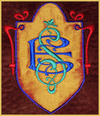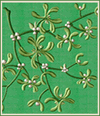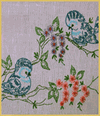Why, When and How to use "In-Hoop Lace Inserting" Technique.
Usually ready-made lace designs are sewn onto an item or garment once the lace design is embroidered. That's why stand-alone lace designs are so easy to use for people who don't know to embroider exactly at the place they want. When a lace design is ready, it takes only seconds to position it at the perfect spot on your project. Then you can attach it to the item or garment, using matching thread.
We have, however, found another technique for sewing CERTAIN TYPES of lace designs into garments. It's possible to do this automatically, while your machine is still embroidering the lace design. We call this technique "In-Hoop Lace Inserting."
"In-Hoop Lace Inserting" has its pros and cons, of course. To use this technique, a design should be properly digitized, and you should start to embroider it exactly at the spot where it's supposed to be located. This requires some accuracy.
Also, this will work only with single lace designs that have a "finished" look on their own and have a kind of frame around them. We are talking about the type of designs that are supposed to be positioned in the middle of the background fabric, NOT on its edge.
The most important advantage of this technique is that the design is sewn into garment so well that the garment can be laundered many times. You may want to use this technique when sewing lace into clothes or linens that must be laundered from time to time.
Another great quality of this technique is that your machine can insert a lace design into fabric in such a way that seams will be absolutely invisible, since they will be located underneath the lace stitches. Embroidery machine can do this very neatly, and can "overlock" the fabric edges at the same time. It's a challenge to do it that well, manually.
GENERAL SUGGESTIONS
Make sure you have the following items at your disposal:
1. Heavy-duty, water-soluble fabric (backing/stabilizer).
2. High-quality polyester machine-embroidery thread.
Regular 40 wt thread is perfect. Just make sure you purchase a quality brand. With lace designs, using strong and NON-stretchy thread is especially important, because they have many stitches, and you would probably prefer to drink coffee or do something fun while your machine is working, instead of babysitting each design for half an hour.
Also, thread breaks can cause the laces to unravel later, and stretchy thread may cause your design to deform after laundering.
We've also noticed that it is better to embroider lace designs at a slightly slower speed than at the high speed used for regular designs. The lace comes out more beautifully this way.
3. Stand-alone lace-machine embroidery designs
4. Temporary adhesive spray
MAIN STEPS
1. Select an appropriately digitized lace design that supports in-hoop insertion, and print its 1:1 scale paper template.
2. Hoop two layers of strong, water-soluble backing. Fabric-type WSB is better than film-type WSB for this purpose.
3. Take the garment onto which you want to insert your lace design, position it over the hooped, water-soluble backing, and secure it over the backing. The spot where the lace design will be inserted should be exactly in the middle of your hoop. You can achieve this positioning by using a design paper template and "Pins Trick" to guide you (see photos and instructions below).
4. When the garment is secured over the water-soluble backing, the first design thread is embroidered. This should be a running stitch. It's purpose is to outline the area of fabric where you should cut out a hole for the lace insert.
5. Once the first thread is embroidered, remove the hoop and carefully cut out the inside of the outlined area of fabric, as close to the stitches as you can. Cut away only the fabric. The backing MUST remain undamaged, to support the lace design.
6. Insert the hoop back into the machine and embroider the rest of the design, following the thread change list. Once the design is ready, just take the garment out of the hoop, cut away the large edges of water-soluble fabric, and wash the rest of it away. That's it. You�re ready!
Another thought� Instead of water-soluble fabric, it's possible to use regular fabric in a contrasting color. This can create a very beautiful effect. Although the design will no longer be lace, it will look great in many cases. This approach is especially useful when you want to embroider it onto a piece of cloth where you don't want it to be translucent. Alternatively, you can do it as lace and then insert a piece of contrasting fabric behind the lace, after it has been washed.
WARNINGS
1. NEVER resize lace designs. Chances are good that this will ruin them completely. They are very sensitive and precise. While regular design may resize well, a resized lace design will most probably fall apart after you wash away the water soluble backing.
2. If you are using new supplies (thread, stabilizer), try them out first on one small test design, to see if everything is okay. Stitch it, wash away the water soluble, and dry it, just to be sure that your backing and thread are working well together. Only then continue with your main project.
We have, however, found another technique for sewing CERTAIN TYPES of lace designs into garments. It's possible to do this automatically, while your machine is still embroidering the lace design. We call this technique "In-Hoop Lace Inserting."
"In-Hoop Lace Inserting" has its pros and cons, of course. To use this technique, a design should be properly digitized, and you should start to embroider it exactly at the spot where it's supposed to be located. This requires some accuracy.
Also, this will work only with single lace designs that have a "finished" look on their own and have a kind of frame around them. We are talking about the type of designs that are supposed to be positioned in the middle of the background fabric, NOT on its edge.
The most important advantage of this technique is that the design is sewn into garment so well that the garment can be laundered many times. You may want to use this technique when sewing lace into clothes or linens that must be laundered from time to time.
Another great quality of this technique is that your machine can insert a lace design into fabric in such a way that seams will be absolutely invisible, since they will be located underneath the lace stitches. Embroidery machine can do this very neatly, and can "overlock" the fabric edges at the same time. It's a challenge to do it that well, manually.
GENERAL SUGGESTIONS
Make sure you have the following items at your disposal:
1. Heavy-duty, water-soluble fabric (backing/stabilizer).
2. High-quality polyester machine-embroidery thread.
Regular 40 wt thread is perfect. Just make sure you purchase a quality brand. With lace designs, using strong and NON-stretchy thread is especially important, because they have many stitches, and you would probably prefer to drink coffee or do something fun while your machine is working, instead of babysitting each design for half an hour.
Also, thread breaks can cause the laces to unravel later, and stretchy thread may cause your design to deform after laundering.
We've also noticed that it is better to embroider lace designs at a slightly slower speed than at the high speed used for regular designs. The lace comes out more beautifully this way.
3. Stand-alone lace-machine embroidery designs
4. Temporary adhesive spray
MAIN STEPS
1. Select an appropriately digitized lace design that supports in-hoop insertion, and print its 1:1 scale paper template.
2. Hoop two layers of strong, water-soluble backing. Fabric-type WSB is better than film-type WSB for this purpose.
3. Take the garment onto which you want to insert your lace design, position it over the hooped, water-soluble backing, and secure it over the backing. The spot where the lace design will be inserted should be exactly in the middle of your hoop. You can achieve this positioning by using a design paper template and "Pins Trick" to guide you (see photos and instructions below).
4. When the garment is secured over the water-soluble backing, the first design thread is embroidered. This should be a running stitch. It's purpose is to outline the area of fabric where you should cut out a hole for the lace insert.
5. Once the first thread is embroidered, remove the hoop and carefully cut out the inside of the outlined area of fabric, as close to the stitches as you can. Cut away only the fabric. The backing MUST remain undamaged, to support the lace design.
6. Insert the hoop back into the machine and embroider the rest of the design, following the thread change list. Once the design is ready, just take the garment out of the hoop, cut away the large edges of water-soluble fabric, and wash the rest of it away. That's it. You�re ready!
Another thought� Instead of water-soluble fabric, it's possible to use regular fabric in a contrasting color. This can create a very beautiful effect. Although the design will no longer be lace, it will look great in many cases. This approach is especially useful when you want to embroider it onto a piece of cloth where you don't want it to be translucent. Alternatively, you can do it as lace and then insert a piece of contrasting fabric behind the lace, after it has been washed.
WARNINGS
1. NEVER resize lace designs. Chances are good that this will ruin them completely. They are very sensitive and precise. While regular design may resize well, a resized lace design will most probably fall apart after you wash away the water soluble backing.
2. If you are using new supplies (thread, stabilizer), try them out first on one small test design, to see if everything is okay. Stitch it, wash away the water soluble, and dry it, just to be sure that your backing and thread are working well together. Only then continue with your main project.
to keep reading, please click on the link |




